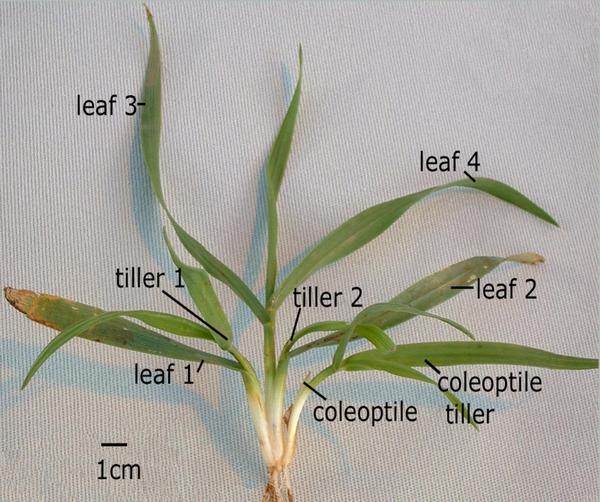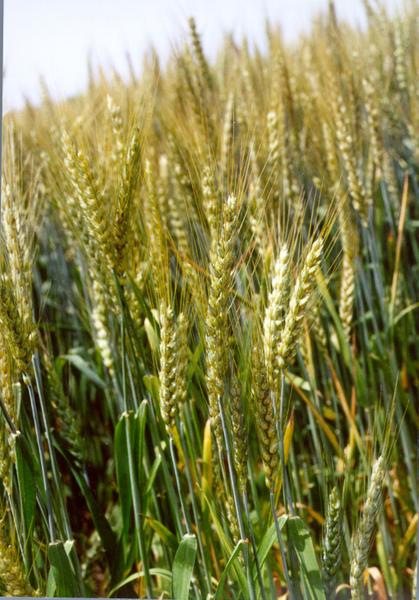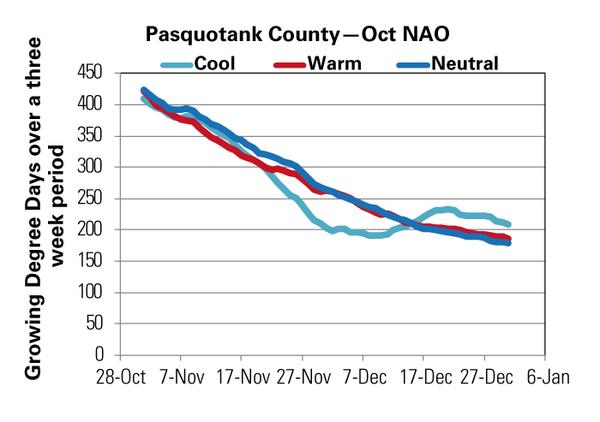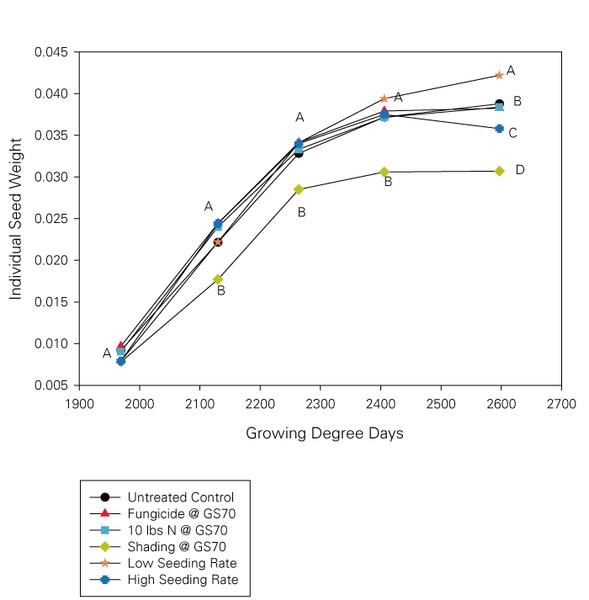Introduction to Adaptive Wheat Management
Growing environments for wheat are highly variable, with tremendous changes in temperature and rainfall during the growing season from one season to the next. One season the wheat may experience warm temperatures and little rainfall; the next season may have very cold temperatures with excessive moisture. These extreme conditions can occur at different times within a single growing season. Managing wheat for optimal yield in these environments is extremely difficult. Using a formulistic approach (planting on the same date with the same variety, seeding rate, and fertility practices) often results in less than optimal yield and lower economic returns. Adaptive management is a system that adapts management practices to current and predicted environmental conditions. It is based on an understanding of the key environmental factors and growth periods that influence wheat growth, yield components, and final yield. Using an adaptive management approach, a grower adjusts practices such as variety selection, seeding rate, planting date, amounts and timing of fertilizer applied, and the use of special practices such as growth regulators or pesticides to optimize yield based on the environmental conditions of a given growing season.
Understanding How Weather-Related Factors Influence Wheat Growth and Development
To properly use an adaptive management approach on your farm, you must first understand the key environmental factors that drive wheat growth and how to manage those factors during critical periods of wheat growth and development.
The most important influence on wheat growth and development is temperature. Temperature directly influences leaf and tiller development, stem elongation, the size of the spike or head of wheat, kernel development, and the milling and baking quality of the wheat flour. Very cold or very warm temperatures can negatively influence growth, development, and yield. Some temperature extremes, such as a late-spring freeze, can have catastrophic impacts on grain yield. For a successful management approach, you must understand how temperature can affect wheat growth during three critical growth stages: planting to jointing (Zadoks GS 00 to GS 22), jointing to flowering (Zadoks GS 30 to GS 60), and flowering to maturity (Zadoks GS 60 to GS 90) (Figure 1).
Impact of Temperature: From Seeding to Production of Two Tillers (GS 00 to GS 22)
The amount of heat units accumulated by the wheat plant influences the rate of growth, number of leaves, and number of tillers developed during the period from seeding to the point at which the plant has two tillers (Figure 2). To calculate heat units for wheat, subtract the base temperature (which for wheat is 32ºF) from the average temperature for the day, as shown in the equation below.
((Maximum Temperature + Minimum Temperature) ÷ 2) – 32
Figure 3 shows the relationship between heat units calculated from average daily temperatures and leaf growth. Note that the early periods of both the November and December planting dates show slower growth (fewer leaves developed per growing degree day). The slow growth was due to a cold, rainy period in late November and early December that caused stress. The stress reduced the rate of growth compared to the period from late December through February, which was unusually warm and dry.
It takes 300 to 400 heat units for the plant to produce three leaves, after which the plant begins to develop tillers. The rate at which tillers are produced is a function of the number of leaves, which is a function of heat units accumulated. Research shows that warm conditions with little or no stress from freeze events or lack of nutrients are critical to rapid early growth (Oakes et al. 2016). Such growth produces tillers that are capable of producing large spikes with more and larger kernels. Stress from freezes, lack of nutrients, or excess or lack of water can reduce the plants’ response to temperature as shown by the differently sloped lines in Figure 3.
Impact of Temperature: Jointing (GS 30) to Bloom (GS 60)
Jointing to bloom is the growth and development period with the most impact on final yield. Temperature has two important influences on wheat development and yield during this critical period. First and most important is the impact of low temperatures (freeze events). Growers must manage wheat to avoid very cold temperatures during this period. Table 1 shows minimum temperatures and associated freeze injuries during this period. Wheat must be managed so that heading and flowering occur after the last freeze event. The second important influence of temperature during this period is the impact on elongation of the internodes and in the development of the number of kernels in the spike (Figure 4). Temperatures between 45ºF and 75ºF result in optimal growth and yield. Very warm temperatures reduce cell elongation and number of kernels. Though it is impossible to control temperature, it is possible to manage when the plant begins jointing. If growers manage when wheat reaches the jointing period, plants can better tolerate freeze events or temperatures that are too warm for optimal kernel development.
| Growth stage
|
Approximate injurious temperature (two hours)
|
Primary symptoms
|
Yield effect
|
|---|---|---|---|
| Tillering
|
12ºF (-11ºC)
|
Leaf chlorosis; burning of leaf tips; silage odor; blue cast to fields
|
Slight to moderate
|
| Jointing
|
24ºF (-4ºC)
|
Death of growing point; leaf yellowing or burning; lesions, splitting, or bending of lower stem; odor
|
Moderate to severe
|
| Boot
|
28ºF (-2ºC)
|
Floret sterility; spike trapped in boot; damage to lower stem; leaf discoloration; odor
|
Moderate to severe
|
| Heading
|
30ºF (-1ºC)
|
Floret sterility; white awns or white spikes; damage to lower stem; leaf discoloration
|
Severe
|
| Flowering
|
30ºF (-1ºC)
|
Floret sterility; white awns or white spikes; damage to lower stem; leaf discoloration
|
Severe
|
| Milk
|
28ºF (-2ºC)
|
White awns or white spikes; damage to lower stems; leaf discoloration; shrunken, roughened, or discolored kernels
|
Moderate to severe
|
| Dough
|
28ºF (-2ºC)
|
Shriveled, discolored kernels; poor germination
|
Slight to moderate
|
Impact of Temperature: Flowering (GS 60) to Maturity
Temperature during this period determines kernel size and grain quality. Temperatures above 86ºF reduce starch deposition and grain weight. Continuous daily canopy temperatures above 86ºF result in senescence and the end of grain growth. For the largest yield, a grower must maximize the length and efficiency of the grain fill period by preventing canopy temperature above 86ºF. Maintaining green leaf area is essential in maximizing transpiration.
Management: Adapting to Changing Weather Conditions
Managing the Period from Seeding to Production of Two Tillers
Three factors are key for managing temperature and wheat growth during the critical early growth period: planting date, seeding rate, and application of nutrients (nitrogen). Your first goal is to select a planting date that gives you the best opportunity to accumulate 300 to 400 heat units as rapidly as possible. With this optimal start, the plant can begin producing tillers quickly while at the same time limiting the possibility of accumulating too many heat units (resulting in excess growth prior to GS 30 or jointing). Having two tillers on the plant by Dec. 25 is ideal, resulting in a plant with optimal yield potential and reduced risk of disease or late-spring freeze damage. Unfortunately, due to drastically different weather patterns in the fall from year to year, it is difficult to know when to plant wheat to achieve ideal plant growth.
Fortunately, some strategies can improve your ability to achieve ideal plant growth and maximize yield. One of the best tools is to use climate patterns to predict fall and winter weather conditions. Figure 5 shows how you can use the North American Oscillation (NAO) index to determine how many growing degree days (GDD) to expect in November and early December. The NAO index shows the difference in barometric pressure between the high and low pressure centers in the Northern and Southern Atlantic oceans during the period from late August to early October. This pattern is a good predictor of potential heat units during the late fall and early winter. If this pattern predicts a cool fall, you should plant most wheat varieties before Nov. 17 to have enough heat units to produce two tillers by Dec. 25. With a cool pattern, there is little risk of planting too early; wheat could be planted in mid October with little risk of flowering too early in the spring. When a warm or neutral fall is predicted, wheat should be planted later to avoid the risk of too much growth at the wrong time, resulting in lodging from plants that are too tall; planting dates as late as mid December still provide enough time to make two tillers by Christmas. In a neutral or warm season, optimal planting dates range from the first week in October (late maturing wheat only) to the middle of December (early maturing wheat). You can obtain the latest information on the predicted NAO from the National Oceanic and Atmospheric Administration (NOAA). Growers should check on the NAO prediction in early October and then use Table 2 to determine potential planting dates for wheat for the upcoming growing season.
| Wheat Maturity (Growing Degree Days to Flowering)
|
NAO Prediction COOL
|
NAO Prediction NEUTRAL or WARM
|
|---|---|---|
| Early (< 1790)
|
20 Oct. to 1 Dec.
|
10 Nov. to 15 Dec.
|
| Medium (1790 to 1849)
|
1 Oct. to 17 Nov.
|
20 Oct. to 15 Dec.
|
| Late (> 1850)
|
1 Oct. to 10 Nov.
|
1 Oct. to 1 Dec.
|
The next tool that should be used to control temperature and adjust management for different climatic conditions is seeding rate. When planting early in the fall (early to mid October) in a neutral or warm season, decrease seeding rates to allow for more growth and leaf development due to more potential heat units. In a neutral or warm season, plant 12 to 15 seeds per row-foot during this period. When the NAO index predicts a cool fall, you can increase seeding rates to 15 to 20 seeds per row-foot. From late October to mid November, plant 18 to 22 seeds per row-foot when a warm or neutral season is predicted. In a season when cooler fall temperatures are predicted, increase seeding rates to 22 to 28 seeds per row-foot. Likewise, when planting late in a neutral or warm season, seeding rates of 22 to 28 seeds per row-foot are optimal. In a cool season, however, you should plant 28 to 34 seeds per row-foot (or better yet, avoid planting late when a cool season is predicted). In summary, seeding rates can be used to control plant density when temperatures are likely to result in too much or too little growth.
At planting, apply nitrogen at a rate of 30 lbs per acre when cooler temperatures are expected or when planting later in the fall. Nitrogen helps reduce stress from cool temperatures and promotes more growth during warm periods. Applied in the fall, nitrogen improves root development during cool, wet periods.
Conversely, lack of nitrogen can delay plant growth and development. In instances of warm January and February temperatures, delaying split-nitrogen application can help slow plant development and prevent early jointing.
Managing the Period from Jointing to Bloom
The available tools for managing temperature during jointing-to-bloom include variety selection, maturity (as in how many growing degree days it takes to reach flowering), planting date, and in special cases the use of a growth regulator. Selecting a variety based on its maturity rating is the most important of these tools and is closely tied to the anticipated planting date. You want to use maturity to delay jointing during the period from March 15 to March 25. Jointing too early will result in an increased risk from freeze events. On the other hand, jointing too late increases the chance that wheat will experience very warm temperatures, resulting in less growth and fewer kernels. Unfortunately, by the time wheat reaches jointing, it is too late to change course. It is all the more important that wheat growers anticipate the weather conditions by using the NAO index or some other means of predicting fall and early winter weather conditions. NOAA issues forecasts of fall and winter weather conditions as early as late August. Using the NOAA predictions, growers can use the guidelines in Table 2 for selection of variety maturity class and Table 3 for seeding rates.
| Planting Period | NAO Prediction COOL |
NAO Prediction NEUTRAL or WARM |
|---|---|---|
| Seeds per Row Foot | ||
| 1 Oct. to 20 Oct.
|
15 to 20
|
10 to 15
|
| 20 Oct. to 12 Nov.
|
22 to 28
|
18 to 22
|
| 12 Nov. to 15 Dec.
|
28 to 34
|
22 to 28
|
The other potential tool for managing growth during this critical period is the use of a growth regulator. Growth regulators such as Palisade® or CERONE® affect stem elongation and the size of the spike. These chemicals are most useful in situations where excess growth has occurred between emergence and the two-tiller period. Growers should consider using a growth regulator under two conditions.
- Excess plant density: This occurs when a large amount of heat units during the winter have produced plant densities of 150 tillers per square foot or more. In North Carolina we cannot support this many plants per square foot (Figure 6); the excess density results in loss of plants during the jointing-to-heading period and excessive demand for nutrients and water. A growth regulator used just prior to or at jointing can help prevent late tillering and safely reduce plant density.
- Excess plant height: Too much early growth and dense stands often lead to tall plants that are prone to lodging (bending over or falling down). The use of a growth regulator from early flag-leaf initiation to heading can help reduce stem elongation and dramatically reduce plant height.
Managing the Period from Flowering to Maturity
The key to managing wheat during this growth period is to make sure that the plant has an adequate root system and adequate nitrogen supply to allow the plant to transpire enough water to keep the canopy cool. In a practical approach, this comes down to the availability of nitrogen during the period from flowering to maturity. Research has shown that efforts to apply additional nitrogen at this time are usually not successful because it is too late to concentrate nitrogen in the tissues (Figure 7). The best way to ensure that the plant has adequate nitrogen during this period is to apply nitrogen as close to the start of jointing as possible and to adjust the amount of nitrogen applied prior to jointing based on the amount of biomass or growth that the wheat has at jointing. When early wheat growth is ideal, the grower should apply up to 120 units of nitrogen at or prior to jointing. When there is excess growth or the wheat has more than three tillers per plant, the grower should apply up to 150 units of nitrogen prior to jointing. Such a strategy allows the grower to adjust for previous growth and developmental conditions and still maintain leaf function and canopy temperature during the period from flowering to maturity. Research suggests that splitting nitrogen application by applying some nitrogen in early February and the rest at jointing helps improve root development and increases nitrogen in the tissue during this period—particularly important in a year when excessive rainfall occurs in February and early March (Oakes et al. 2015).
Using the Adaptive Management System
Growers interested in using an adaptive management system should develop a plan based on anticipated weather conditions, frequent analysis of crop growth, and updates on growth stage (tiller and growth targets that need to be achieved by a given date). The grower should follow these steps:
- Collect all information on anticipated temperature and rainfall conditions for the coming fall (via NOAA) during late August through September. Use the NAO index, weather forecasts, or other pertinent information to determine what temperature conditions are most likely to occur in the fall and early winter. These temperatures will determine how many growing degree days the crop will experience.
- Identify the optimal planting date. Once you have identified the most likely temperature profile for fall and winter, use Table 2 to select the range of planting dates to consider. Don’t forget to adjust for soil conditions under no-till or high residue situations; such conditions require more heat units to achieve growth and development.
- Anticipate jointing time by selecting the proper maturity group for your variety based on targeted planting dates.
- Adjust anticipated seeding rate (Table 3) and nitrogen use based on current weather conditions as planting time approaches. If weather is warmer than anticipated, reduce seeding rates and withhold nitrogen at planting. If weather is cooler than anticipated, increase seeding rate and apply nitrogen at planting or closely after planting. Don’t forget to adjust practices based on pest pressure. If warmer than normal, consider whether Hessian fly or diseases such as barley yellow dwarf may present problems.
- Scout your crop to see how it is approaching the goal of two tillers by Dec. 25. If the weather has turned colder or wetter than anticipated, use split-nitrogen applications whenever temperatures are above 40ºF to help stimulate growth. If the weather has turned warmer or drier than anticipated, withhold your nitrogen application until just before jointing or consider the use of a growth regulator to limit the number of excess tillers produced and to ensure that nitrogen is available through the flowering period.
- Monitor the crop following cold weather or heavy rainfall events. Plants should recover their green color quickly. If they do not recover quickly, that is a sign of poor root development. Consider applying nitrogen in late January or early February (whenever temperatures start to warm up) to improve root growth and development. Watch for other sources of stress that may limit the plants’ response to warm temperatures and, if possible, take corrective measures.
- Anticipate jointing between March 15 and March 25 if your planting date and variety maturity class were on target.
- Monitor the crop for disease and growth after flowering: this is the time to protect yield potential. If the crop is failing, consider whether additional expenses, such as applying a fungicide or late-season insecticide, are justified. After flowering if warm, dry weather is experienced in May, growers with irrigation capacity should consider at least one application of water to keep canopy temperatures below 86ºF.
Conclusion: A Successful Wheat Crop!
Successful wheat management in today’s economic environment requires the wheat grower to manage the temperature environment of the crop. The adaptive wheat management system is a way for wheat growers to do just that. Following an adaptive system, growers can maximize yield while at the same time not wasting resources on a crop that has little yield potential. A successful adaptive management system can lower costs by helping prevent more than one application of nitrogen in many cases; by staging wheat development during periods where pest or disease pressure is lower; and by making it possible for the crop to resist pests.
References
Oakes, J., R. Heiniger, J. Murphy, C. Crozier, and G. Wilkerson. 2015. “Kernel Development in Wheat.” Crop, Forage & Turfgrass Management 1:2015-0156.
Oakes, J., R. Heiniger, C. Crozier, J. Murphy, and G. Wilkerson. 2016. “Phyllochron Interval and Yield Response to Planting Date and Fertility in Wheat.” Crop, Forage & Turfgrass Management 2:2016-03-0026.
Acknowledgments
This publication is supported in part by a grant from the North Carolina Small Grain Growers Association Inc. The association provides funds to support research programs at North Carolina State University for the benefit of the small grain industry, general consumers, and the public at large.
Publication date: Sept. 19, 2019
Reviewed/Revised: Sept. 23, 2024
AG-865
The use of brand names in this publication does not imply endorsement by NC State University or N.C. A&T State University of the products or services named nor discrimination against similar products or services not mentioned.
N.C. Cooperative Extension prohibits discrimination and harassment regardless of age, color, disability, family and marital status, gender identity, national origin, political beliefs, race, religion, sex (including pregnancy), sexual orientation and veteran status.







